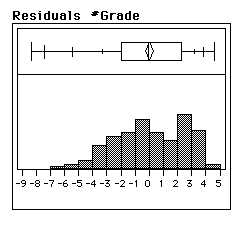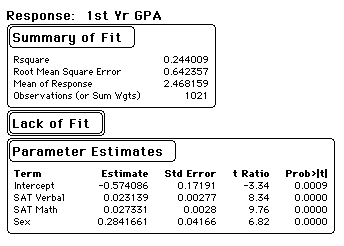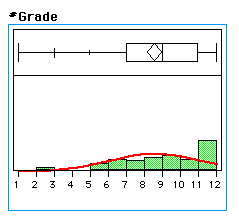Statistical Ideas
Next: About this document
Up: Sex Bias and the Scholastic Aptitude Test
Previous: Background
- Linear Regression
- Multiple Regression
- Histograms
- Data/Sample Bias
This topic provides a good introduction to analysis of linear and multiple
regression on a computer statistical package. The data from different years
also may be used in comparative histograms for analysis. JMP was the software
used in this write-up. The data and contrasting study results mentioned in part
I raises interesting questions about the source of data and bias of the researchers.
-How to Qualitatively and Quantitatively Look at Two Factors and Determine the
Validity of a Linear Model
For this example, use the math SAT scores and numeric grade in Math 3-92 as the
 and
and  in the scatter plot (Separate data files accompany this profile).
In order to set up a scatter plot and perform a regression, select Fit
in the scatter plot (Separate data files accompany this profile).
In order to set up a scatter plot and perform a regression, select Fit  by
by  .
Next, select Fit Line to fit a simple regression line through the data points.
The regression line minimizes the sum of squared distances from each sample point
to the line of fit. It would be useful to next find the value of r, the correlation
coefficient, which helps determine if there is a linear relationship between the
two variables. To find
.
Next, select Fit Line to fit a simple regression line through the data points.
The regression line minimizes the sum of squared distances from each sample point
to the line of fit. It would be useful to next find the value of r, the correlation
coefficient, which helps determine if there is a linear relationship between the
two variables. To find  in JMP, fit any Density Ellipse and check under the
Bivariate Statistics (Figure 1).
in JMP, fit any Density Ellipse and check under the
Bivariate Statistics (Figure 1).

Figure 1: Linear Model
Next, save the Predicteds, the points along the best fit line. Then you can see
how far the actual values deviate from the predicted values.
It is also good to save the Residuals which are points measuring the distance of
a point from its predicted value. This value is measured vertically. Then plot
the residuals under Distribution of Y's and see how they fall under the histogram
or normal curve (Figure 2). The closer they come to a bell shape, the better the model.
You can also plot the residuals by the actuals under Fit X by Y and see if there is
clumping in the upper left and lower right corners (Figure 3) If there is, then there
is something wrong with the model because the points should be rather evenly distributed.

Figure 2: Math 3 Grade Residuals

Figure 3: Actual Grades versus Grade Residuals
This two variable method is good for preliminary analysis and should be used to
look at the correlation between sex and scores and other combinations. However,
for a more thorough analysis, there is multiple regression.
-How to Perform Multiple Regression
Select Fit  by
by  s to start an analysis of the effects of more than one independent
variable. For this example, use the ETS Validity Data and choose SAT Verbal, SAT
Math, and Sex as the
s to start an analysis of the effects of more than one independent
variable. For this example, use the ETS Validity Data and choose SAT Verbal, SAT
Math, and Sex as the  s (independent variables).
s (independent variables).  (dependent variable) will be
Freshman GPA (a.k.a. 1st Yr GPA).
(dependent variable) will be
Freshman GPA (a.k.a. 1st Yr GPA).
-What the Multiple Regression Summaries Mean

Figure 4: Results of Multiple Variable Analysis
The Summary of Fit (Figure 4) contains some important information. The R square is
akin to the r used in the two variable linear correlation. The R square statistic
represents the proportion of total variation in freshman year GPA as explained by
the regression of freshman year GPA on the independent variables (Pindyck, 61).
The smaller R square is, the less your  s are accountable for the
outcome of
s are accountable for the
outcome of  . An R Square of 1 would suggest that you have adjusted all the
influencing factors and you have a well fit model. A R square greater than 1 does
not imply a good fit. The Root Mean Square error is the unit error on each side
of the mean for
. An R Square of 1 would suggest that you have adjusted all the
influencing factors and you have a well fit model. A R square greater than 1 does
not imply a good fit. The Root Mean Square error is the unit error on each side
of the mean for  . The Mean of Response is just the mean of
. The Mean of Response is just the mean of  .
Observations is just the same as the number of rows.
.
Observations is just the same as the number of rows.
Some other important information is contained under the header,
Parameter Estimates (Figure 4).
The numbers in the first column after the  s are used to create the
equation/model we are looking at. For example, freshman year
GPA =
s are used to create the
equation/model we are looking at. For example, freshman year
GPA =  . One can interpret .023SATV as:
controlling for the other variables, a 1 point increase in the SAT verbal score,
freshman GPA should be .023 higher. (Note that the intercept is negative when
in theory it should be greater than zero- hence our model is far from being
comprehensive). Since the number before Sex is positive, this implies that being
female has a positive effect on GPA. So, where men and women have the same SAT
scores, women can be expected to do better as a freshman in this regression. If sex
was irrelevant in this equation the sex coefficient would be zero.
. One can interpret .023SATV as:
controlling for the other variables, a 1 point increase in the SAT verbal score,
freshman GPA should be .023 higher. (Note that the intercept is negative when
in theory it should be greater than zero- hence our model is far from being
comprehensive). Since the number before Sex is positive, this implies that being
female has a positive effect on GPA. So, where men and women have the same SAT
scores, women can be expected to do better as a freshman in this regression. If sex
was irrelevant in this equation the sex coefficient would be zero.
You might also want to save the Predicted Formula, which for JMP is located under
the $ icon, because it will provide the formula just described under the estimate column.
Histograms can be created by selecting the header, Distribution of  s, and then
assigning a
s, and then
assigning a  variable. Seeing how the
variable. Seeing how the  s fall under the normal curve can be
useful in comparative analysis. For example, the grades for Economics 1 are
provided for classes from 1991 and 1992. It would be helpful to assign the grades
as the
s fall under the normal curve can be
useful in comparative analysis. For example, the grades for Economics 1 are
provided for classes from 1991 and 1992. It would be helpful to assign the grades
as the  variable under the curve and compare the curves for both years (Figures 5 and 6).
This way it can be observed whether or not there was a significant change in how
the grades were distributed from year to year. Doing this for different variables,
enables the analyzer to look for other trends while holding constant as many other
factors as possible.
variable under the curve and compare the curves for both years (Figures 5 and 6).
This way it can be observed whether or not there was a significant change in how
the grades were distributed from year to year. Doing this for different variables,
enables the analyzer to look for other trends while holding constant as many other
factors as possible.

Figure 5: Grade distribution for Econ1-91

Figure 6: Grade distribution for Econ1-92
The ETS has suggested that a purely random sample is next to impossible to
acquire for research on the issue of sex bias and the SAT. Examining the
samples used in each study outlined in this profile can help determine the
validity of the research results.
SOURCES
(* indicates possible classroom material)
Baron, Jonathan, and M. Frank Norman. ``SATs, Achievement Tests, And High-
School Class Rank As Predictors Of College Performance." Educational
and Psychological Measurement, 1992, 52: 1047-1055.
Brush, Stephen G. ``Women in Science and Engineering." American Scientist.
September-October 1991, Vol. 79: 404-419.
*Burton, Nancy W., Charles Lewis, and Nancy Robertson. College Board Report
No. 88-9: Sex Differences in SAT Scores. New York: College Entrance Examination Board, 1988.
Chatterjee, Samprit, and Bertram Price. Regression Analysis By Example.
2nd ed. New York: John Wiley & Sons, 1991.
Kaufman, Susan. ``SAT-isfaction Not Guaranteed." Chicago Tribune, 12 April
1987: 2C.
Lewis, Charles. Educational Testing Service. Princeton, New Jersey. 1992-93.
Lubetkin, Julie. The Scholastic Aptitude Test: A Valid and Unbiased Predictor
of College Performance?, Senior Thesis, Woodrow Wilson School of Public and
International Affairs, Princeton University, 1988.
* Piccoli, Sean. ``Charges Persist SATs Biased Against Women and Minorities."
The Washington Times, 5 August 1991: G6.
*Rosser, Phyllis. The SAT Gender Gap. Washington DC: Center for Women Policy
Studies, 1989: 29-67.
Rowe, Jonathan. ``Scholastic Aptitude Test Scores: Are They Unfair to Women?"
The Christian Science Monitor, 20 April 1987: 23.
*Sall, John, Katherine Ng, and Michael Hecht. JMP [computer statistics software].
SAS Institute: Cary [NC], 1989.
*Wainer, Howard and Linda S. Steinberg. ``Sex differences in Performance on the
Mathematics Section of the Scholastic Aptitude Test: A Bidirectional Validity
Study." Harvard Educational Review, Vol. 62 No. 3 Fall 1992.
Walker, Judge John M. United States District Court for the Southern District of
New York. Khadijah Sharif v. New York State Education Department. No. 88 Civ.
8435 (JMW). Lexis 961, Decided 3 Feb. 1989.
Next: About this document
Up: Sex Bias and the Scholastic Aptitude Test
Previous: Background
laurie.snell@chance.dartmouth.edu
 and
and  in the scatter plot (Separate data files accompany this profile).
In order to set up a scatter plot and perform a regression, select Fit
in the scatter plot (Separate data files accompany this profile).
In order to set up a scatter plot and perform a regression, select Fit  by
by  .
Next, select Fit Line to fit a simple regression line through the data points.
The regression line minimizes the sum of squared distances from each sample point
to the line of fit. It would be useful to next find the value of r, the correlation
coefficient, which helps determine if there is a linear relationship between the
two variables. To find
.
Next, select Fit Line to fit a simple regression line through the data points.
The regression line minimizes the sum of squared distances from each sample point
to the line of fit. It would be useful to next find the value of r, the correlation
coefficient, which helps determine if there is a linear relationship between the
two variables. To find  in JMP, fit any Density Ellipse and check under the
Bivariate Statistics (Figure 1).
in JMP, fit any Density Ellipse and check under the
Bivariate Statistics (Figure 1).




 . One can interpret .023SATV as:
controlling for the other variables, a 1 point increase in the SAT verbal score,
freshman GPA should be .023 higher. (Note that the intercept is negative when
in theory it should be greater than zero- hence our model is far from being
comprehensive). Since the number before Sex is positive, this implies that being
female has a positive effect on GPA. So, where men and women have the same SAT
scores, women can be expected to do better as a freshman in this regression. If sex
was irrelevant in this equation the sex coefficient would be zero.
. One can interpret .023SATV as:
controlling for the other variables, a 1 point increase in the SAT verbal score,
freshman GPA should be .023 higher. (Note that the intercept is negative when
in theory it should be greater than zero- hence our model is far from being
comprehensive). Since the number before Sex is positive, this implies that being
female has a positive effect on GPA. So, where men and women have the same SAT
scores, women can be expected to do better as a freshman in this regression. If sex
was irrelevant in this equation the sex coefficient would be zero.
 s fall under the normal curve can be
useful in comparative analysis. For example, the grades for Economics 1 are
provided for classes from 1991 and 1992. It would be helpful to assign the grades
as the
s fall under the normal curve can be
useful in comparative analysis. For example, the grades for Economics 1 are
provided for classes from 1991 and 1992. It would be helpful to assign the grades
as the 
